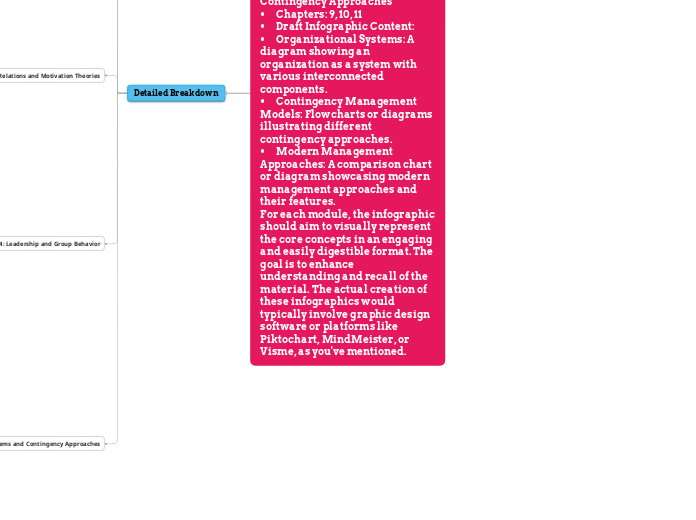Module 1: Foundations and Developments in Management Theory
• Chapters: 1, 2, 12, 15
• Draft Infographic Content:
• Timeline: Display a timeline from 1910 to 2000, highlighting major developments in management theory.
• Key Definitions: A diagram showing various definitions of management, perhaps in a circular format around the central term "Management".
• Global Context: A world map indicating different management practices and theories in various countries.
• Corporate Governance: A flowchart showing the structure of typical business organizations and their governance.
Module 2: Classical and Bureaucratic Theories
• Chapters: 3, 4
• Draft Infographic Content:
• Classical Management Principles: A chart listing the key principles of classical management with brief explanations.
• Weber's Bureaucracy Model: A diagram illustrating the structure of a bureaucratic organization as envisaged by Max Weber.
Module 3: Human Relations and Motivation Theories
• Chapters: 5, 6
• Draft Infographic Content:
• Evolution of Motivation Theories: A flowchart showing the progression from early to later theories of motivation.
• Theorists Comparison: Side-by-side profiles of major theorists in motivation, highlighting their key contributions.
Module 4: Leadership and Group Behavior
• Chapters: 7, 8
• Draft Infographic Content:
• Leadership Styles: A chart or matrix classifying different leadership styles and their characteristics.
• Group Dynamics: An illustration showing various aspects of group behavior and dynamics in organizations.
Module 5: Systems and Contingency Approaches
• Chapters: 9, 10, 11
• Draft Infographic Content:
• Organizational Systems: A diagram showing an organization as a system with various interconnected components.
• Contingency Management Models: Flowcharts or diagrams illustrating different contingency approaches.
• Modern Management Approaches: A comparison chart or diagram showcasing modern management approaches and their features.
For each module, the infographic should aim to visually represent the core concepts in an engaging and easily digestible format. The goal is to enhance understanding and recall of the material. The actual creation of these infographics would typically involve graphic design software or platforms like Piktochart, MindMeister, or Visme, as you've mentioned.
Module 1: Foundations and Developments in Management Theory
Timeline of major developments in management theory from 1910 to 2000
Diagram showing various definitions of management
World map indicating different management practices and theories in various countries
Flowchart showing the structure of typical business organizations and their governance
Module 2: Classical and Bureaucratic Theories
Chart listing the key principles of classical management with brief explanations
Diagram illustrating the structure of a bureaucratic organization as envisaged by Max Weber
Module 3: Human Relations and Motivation Theories
Flowchart showing the progression from early to later theories of motivation
Side-by-side profiles of major theorists in motivation
highlighting their key contributions
Module 4: Leadership and Group Behavior
Chart or matrix classifying different leadership styles and their characteristics
Illustration showing various aspects of group behavior and dynamics in organizations
Module 5: Systems and Contingency Approaches
Diagram showing an organization as a system with various interconnected components
Flowcharts or diagrams illustrating different contingency approaches
Comparison chart or diagram showcasing modern management approaches and their features
Detailed Breakdown
Module 1: Foundations and Developments in Management Theory
Timeline of major developments in management theory from 1910 to 2000
Highlight key events and theories
Include dates and brief descriptions
Diagram showing various definitions of management
Central term 'Management' in the center
Different definitions surrounding the central term
World map indicating different management practices and theories in various countries
Visual representation of countries and their management practices
Labels indicating the theories or practices associated with each country
Flowchart showing the structure of typical business organizations and their governance
Start with the top-level management
Flowchart showing the hierarchy and reporting structure
Module 2: Classical and Bureaucratic Theories
Chart listing the key principles of classical management with brief explanations
List the principles such as division of labor
unity of command
etc
Provide brief explanations for each principle
Diagram illustrating the structure of a bureaucratic organization as envisaged by Max Weber
Visual representation of a bureaucratic organization
Labels indicating the different levels and roles within the organization
Module 3: Human Relations and Motivation Theories
Flowchart showing the progression from early to later theories of motivation
Start with early theories such as Maslow's hierarchy of needs
Show the evolution and progression to later theories like Herzberg's two-factor theory
Side-by-side profiles of major theorists in motivation, highlighting their key contributions
Profiles of theorists such as Maslow
Herzberg
and Vroom
Highlight their key theories and contributions to the field of motivation
Module 4: Leadership and Group Behavior
Chart or matrix classifying different leadership styles and their characteristics
Different leadership styles such as autocratic
democratic
and transformational
Characteristics and traits associated with each leadership style
Illustration showing various aspects of group behavior and dynamics in organizations
Visual representation of group dynamics within an organization
Depict aspects like communication
decision-making
and conflict resolution
Module 5: Systems and Contingency Approaches
Diagram showing an organization as a system with various interconnected components
Visual representation of an organization as a system
Show interconnected components such as inputs
processes
and outputs
Flowcharts or diagrams illustrating different contingency approaches
Flowcharts showing different contingency approaches like the situational approach
Illustrate the factors that influence the choice of management approach in each situation
Comparison chart or diagram showcasing modern management approaches and their features
Compare modern management approaches like total quality management and agile management
Highlight the key features and characteristics of each approach
